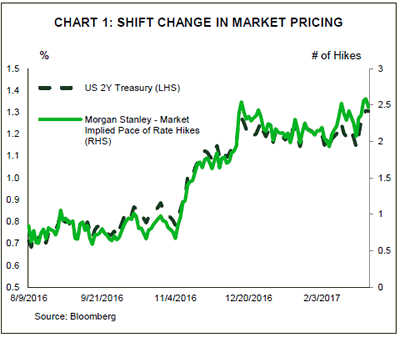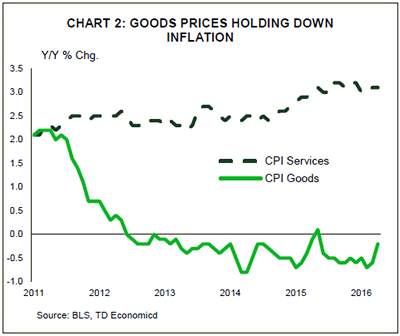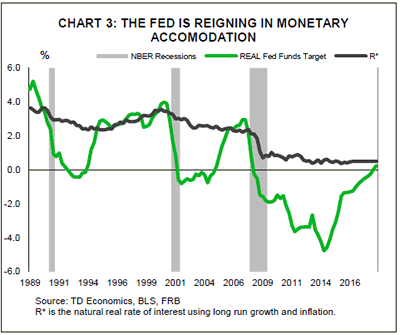HIGHLIGHTS OF THE WEEK
Highlights
- Through a series of speeches over the last two weeks, the Federal Reserve has pulled up market expectations for rate hikes. We now expect three hikes of 25 basis points over the coming year.
- The Fed believes it has made significant progress on its dual mandate of full employment and price stability. Additionally, the improvement in international growth prospects has assuaged fears of market turbulence.
- We expect strong GDP growth and stable inflation, but we would prefer the Fed heed caution as it removes accommodation. There remains a significant amount of labor market slack and a further appreciation of the U.S. dollar could hold back inflation. Finally, this is the time of the cycle that policy errors occur. Raising rates too fast risks economic disruption.
Over the last couple of weeks the tone of the Federal Reserve has turned decidedly hawkish towards rate hikes. Various members have strategically signaled that a rate hike at its March meeting is a highly probable outcome, as are additional hikes in 2017. Markets have taken this warning by pricing in 2-3 rate hikes this year. The barrage of Fed speeches with consistent hawkish tones is no accident; it should be viewed as a deliberate attempt to pull forward market expectations. In the absence of an unforeseen shock, to not deliver a rate hike on March 15th would now threaten the Fed’s credibility in the eyes of market participants.

From the eyes of the Fed
At the risk of sounding like a broken record, we remain entrenched in the view that the U.S. economy has been on solid footing for some time. Stable economic growth has materialized with consistent employment gains, equating to 16 million private sector jobs added since 2010. The unemployment rate is now hovering at estimates consistent with its natural rate. From the purview of the Fed, the objective of full employment is being met. As further proof, tighter labor markets are resulting in wage increases meaningfully outstripping inflation. Firm evidence of this first became apparent back in early 2016. As we have noted previously, our internal models estimate that the pass-through of wages into the Fed’s preferred measure of inflation (core PCE) is 12-18 months. Simply put, inflation appears likely to reach its 2% target by the end of this year. And with that, the Fed will have reached its second mandate of price stability.
There has even been improvement on the Fed’s pseudo ‘third mandate’ of financial stability. Last year, Janet Yellen and company were delayed by a series of event risks that, at the time, were real threats to financial markets. These included fears of a China hard landing, Brexit, and political uncertainty by way of the U.S. election. All of these events caused equity markets to swoon before quickly reversing. Amidst the various speeches in the past two weeks, the Fed appears to also be signaling confidence on global stability. As Fed Governor Brainard noted, "the near-term risks to the United States from abroad appear to have diminished". In fact, synchronized waves of improvement in global production indices have boosted sentiment on corporate profits and economic growth profiles. The improvement has been so substantial that inflation expectations are finally evolving favorably for America’s trade partners. For the time being, financial stability and the Fed’s pseudo third mandate are in check.
With all the boxes checked, the Fed has displayed a brave heart towards pulling forward market expectations. Outside of any major setback, we believe the Fed is poised to raise rates three more times in 2017, with the first occurring at their meeting next week.
What the Fed could be missing
The above describes what we believe the Fed will do. Now, let’s tackle what we think they should do. There are still many factors, not just internationally, that cast a wide band of uncertainty on the U.S. economy. Take the unemployment rate. While the basic measure has returned to its steady state, there is still plenty of controversy around the degree of slack that may still persist, and the Fed should heed caution in tightening too aggressively. In particular, job growth in America has not been paralleled by a strong recovery in the participation of the core working age population (25-54 years). We estimate that approximately 2 million more people can be enticed and absorbed into the job market, which would restrain inflationary pressures through this supply side response. With payroll data showing consistent above trend growth in jobs per month, this corroborates the presence of the remaining labor market slack. The unemployment rate has held relatively constant due to a steady stream of people joining the workforce.
In addition, the persistent disappointment in inflation should not be ignored. The strength of the greenback has contributed to this by way of lower import prices. This can be seen in the wedge between the prices of services and goods – the latter are impacted to a larger degree by currency movements due to greater trade exposure (Chart 2). How much higher the U.S. dollar can appreciate is uncertain, but the risks appear tilted to the upside. We know that a faster pace of rate hikes at a time when other major central banks are still providing a high amount of monetary accommodation should be supportive for the dollar and a headwind for inflation. A swift pace of rate hikes would be more palatable if other central banks were closer to catching up to the Fed. Unfortunately, at the moment, they are falling further behind.

Expansions don’t suddenly die, they suffocate.
The other reason for caution is that this is the time of the economic cycle where policy errors can occur. Recessions are accidents, in part caused when the monetary policy rate rises to a level that chokes off growth (Chart 3). The best way to assess how much the Fed can raise rates before it starts to disrupt the economy is to take the inflation-adjusted policy rate and compare it to the assumption of the natural real rate of interest (R*). The real monetary policy rate is about -1% at the moment and most estimates of R* range from 0 to 1%. In this regard, the current monetary accommodation being provided by the Fed is less than meets the eye. At the pace of rate hikes inferred from the Fed itself, monetary accommodation could be all but eliminated by 2018. What further complicates the outlook is that R* is not directly observable. As such, the Fed would know it has overshot the mark only after observing a negative impact on the economy.

So why the deluge of Fed speeches expressing confidence in a faster rate hiking cycle? At the heart of it is a fear of falling behind the curve on inflation. However, we would be remiss to ignore the fact that the Fed has consistently missed to the downside on inflation for the last five years, and an inflation target should be understood as having symmetry. As members of the Fed have noted before, a lot more is known about controlling high inflation than deflation.
Due to the low run-rate of global and American economic growth, the amount of monetary accommodation is lower than most realize. Too quick an adjustment in rates over the coming quarters has the potential to undermine already low economic growth prospects. This rationale for caution is in addition to the multitude of foreign risks ranging from European bank balance sheets, to political policy uncertainty, to valuations of risk assets globally. So gradual should remain the name of the game, particularly when you’re the only central bank swimming upstream amongst the major advanced economies. The Fed should adopt nerves of steel when inflation starts bumping against its 2% target and resist the urge of being too uncompromising.















